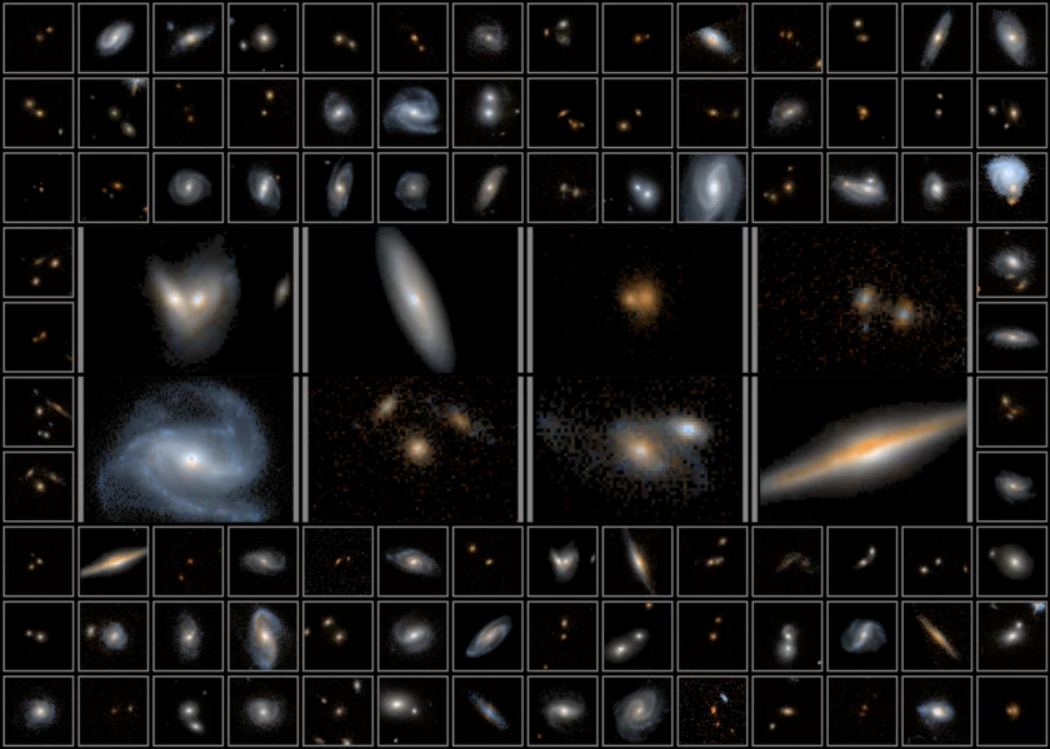The Universe is full of massive galaxies like ours, but astronomers don’t fully understand how they grew and evolved. They know that the first galaxies formed at least as early as 670 million years after the Big Bang. They know that mergers play a role in the growth of galaxies. Astronomers also know that supermassive black holes are involved in the growth of galaxies, but they don’t know precisely how.
A new Hubble survey of galaxies should help astronomers figure some of this out.
The survey is called 3D-Drift And SHift (3D-DASH.) 3D-DASH is a high-resolution near-infrared imaging and spectrometry survey of the sky that maps star-forming regions. It’s the largest of its kind. The goal is to find rare galactic objects that the James Webb Space Telescope can target in follow-up observations.
A paper titled “3D-DASH: The Widest Near-Infrared Hubble Space Telescope Survey” presents the new mosaic. It’ll be published in The Astrophysical Journal and is currently available at the pre-press site arxiv.org. The lead author is Lamiya Mowla, Dunlap Fellow at the Faculty of Arts & Science’s Dunlap Institute for Astronomy & Astrophysics at the University of Toronto.
“Since its launch more than 30 years ago, the Hubble Space Telescope has led a renaissance in the study of how galaxies have changed in the last 10-billion years of the Universe,” said the lead author Mowla. “The 3D-DASH program extends Hubble’s legacy in wide-area imaging so we can begin to unravel the mysteries of the galaxies beyond our own.”
3D-DASH is an improvement on an earlier effort called COSMOS. COSMOS covered a 2 square degree equatorial field using multiple space-based and ground-based telescopes, using spectroscopy, x-ray, and radio imaging. It contains over 2 million galaxies that span 75% of the age of the Universe.

3D-DASH improves on COSMOS by surveying its entire contents in near-infrared. That’s significant because it allows astronomers to see the most distant, earliest galaxies.
Survey size is critical in the study of galaxies. To be productive, surveys have to identify unique phenomena in the Universe: the most massive galaxies, the oldest galaxies, and galaxies on the verge of merging are critical to expanding our understanding of galaxies. So are highly active black holes. But to find those, astronomers need huge images that they can comb through.

Previous surveys weren’t as robust because they were ground-based. They suffered from low resolution, limiting what astronomers could learn from them. 3D-DASH doesn’t suffer from those same limitations.
“I am curious about giant galaxies, which are the most massive ones in the Universe formed by the mergers of other galaxies. How did their structures grow, and what drove the changes in their form?” says Mowla, who began work on the project in 2015 while a grad student at Yale University. “It was difficult to study these extremely rare events using existing images, which is what motivated the design of this large survey.“

DASH stands for Drift And SHift, the name of the new imaging technique that Mowla and her colleagues. DASH is similar to taking a panoramic image with a smartphone. The method captures multiple images that are then stitched together into one enormous image. DASH is a huge time-saver and took images in 250 hours that previously would’ve taken 2000 hours.
It does this by capturing eight images per Hubble orbit rather than one. Only the first of each of the eight images is pointed, and the following seven are unguided and taken while the Hubble “drifts and shifts.” The technique means that the data reduction procedures are more demanding, but the result is worth it.
“3D-DASH adds a new layer of unique observations in the COSMOS field and is also a steppingstone to the space surveys of the next decade,” says Ivelina Momcheva, head of data science at the Max Planck Institute for Astronomy and principal investigator of the study. “It gives us a sneak peek of future scientific discoveries and allows us to develop new techniques to analyze these large datasets.“

3D-DASH provides a list of galactic targets for the James Webb Space Telescope, which should start science observations soon. The ‘Early Universe‘ and ‘Galaxies Over Time‘ are two of the JWST’s overarching science objectives. “Webb’s unprecedented infrared sensitivity will help astronomers to compare the faintest, earliest galaxies to today’s grand spirals and ellipticals, helping us to understand how galaxies assemble over billions of years,” NASA writes. The list of targets from 3D-DASH will help advance those objectives.
You can explore an online version of the mosaic here.
More:
- Press Release: Hubble Space Telescope captures largest near-infrared image to find Universe’s rarest galaxies
- Paper: 3D-DASH: The Widest Near-Infrared Hubble Space Telescope Survey
- Universe Today: A New Survey Takes the Hubble Deep Field to the Next Level, Analyzing Distance and Properties of 1,600 Galaxies

